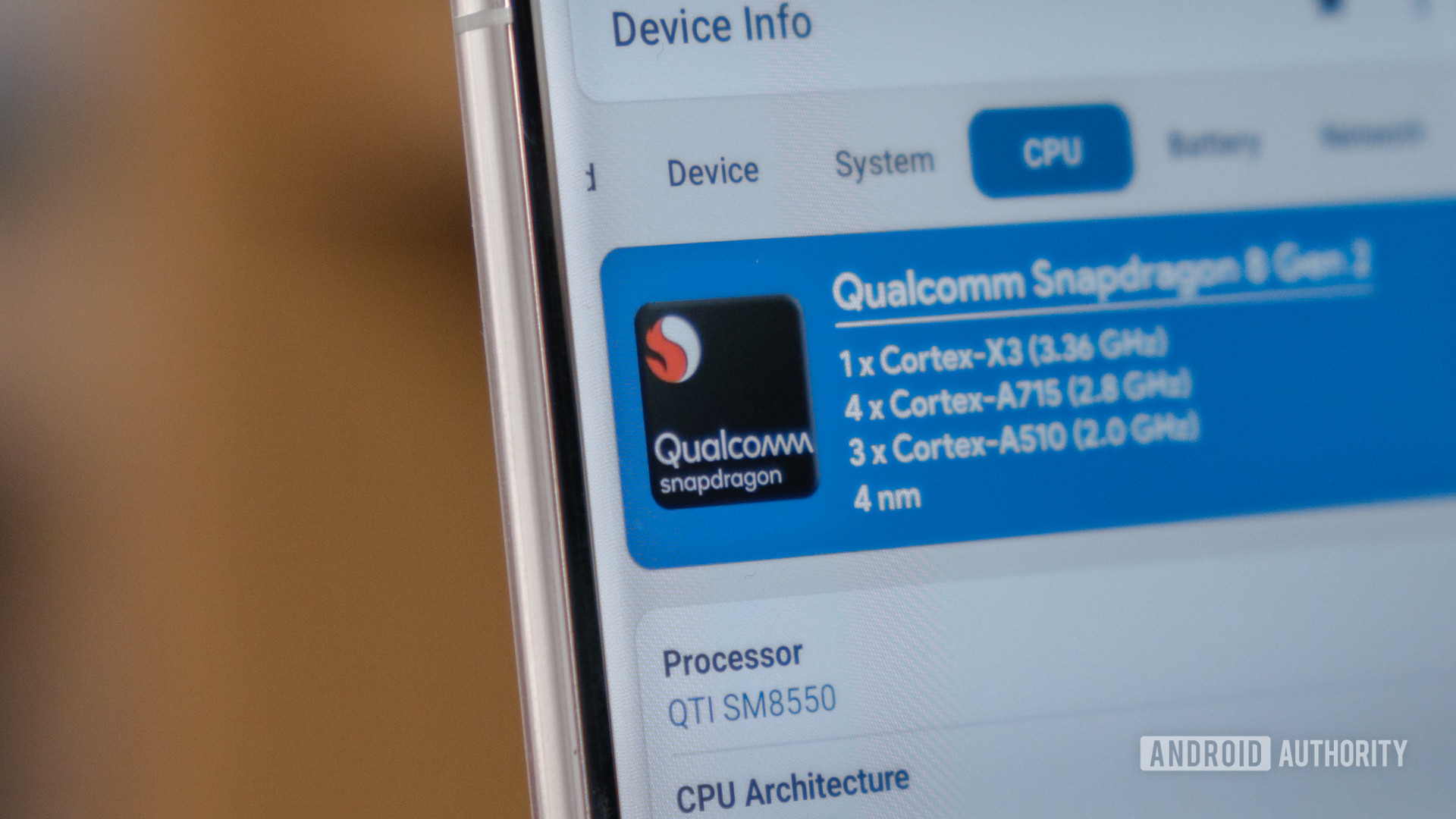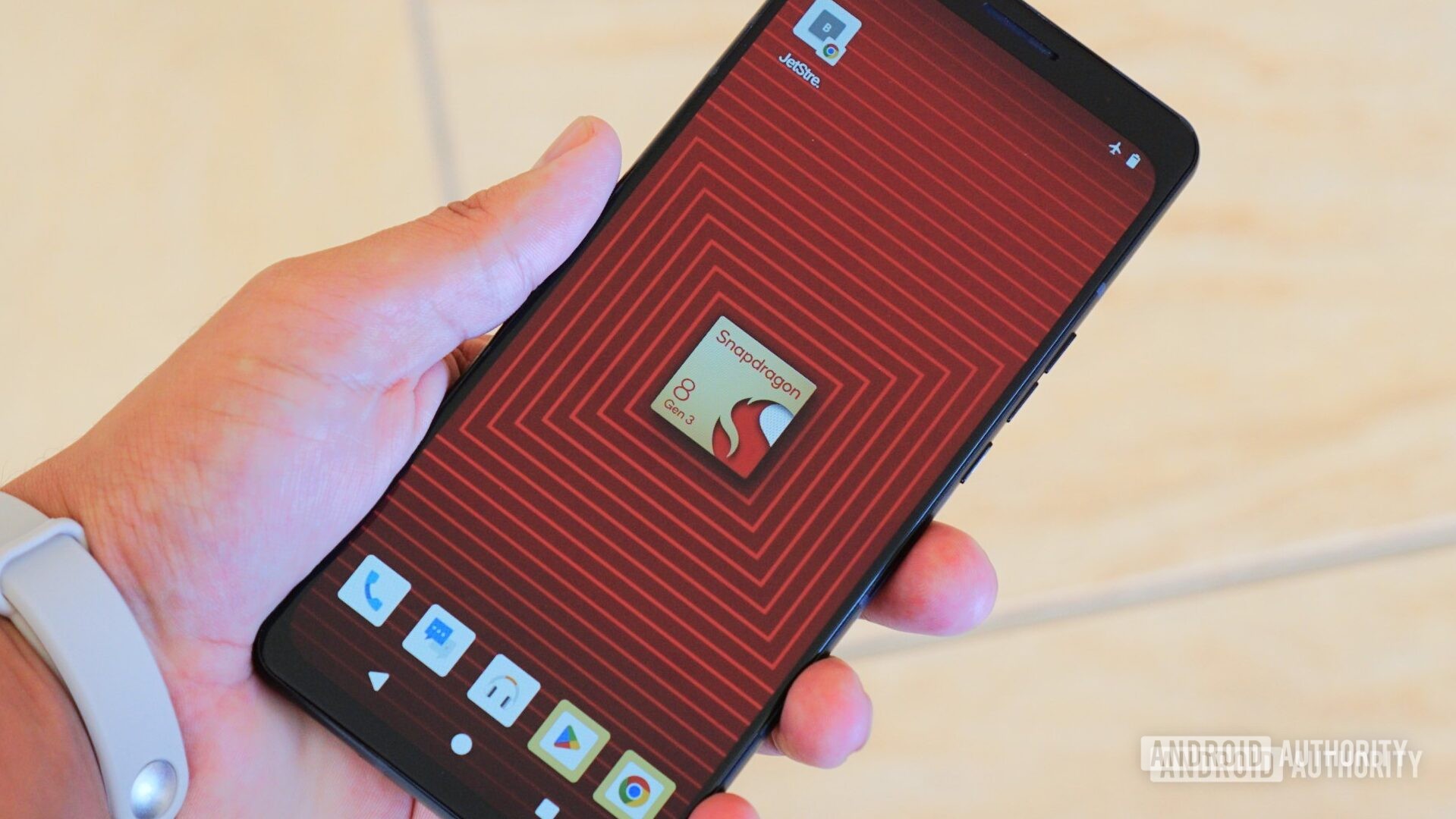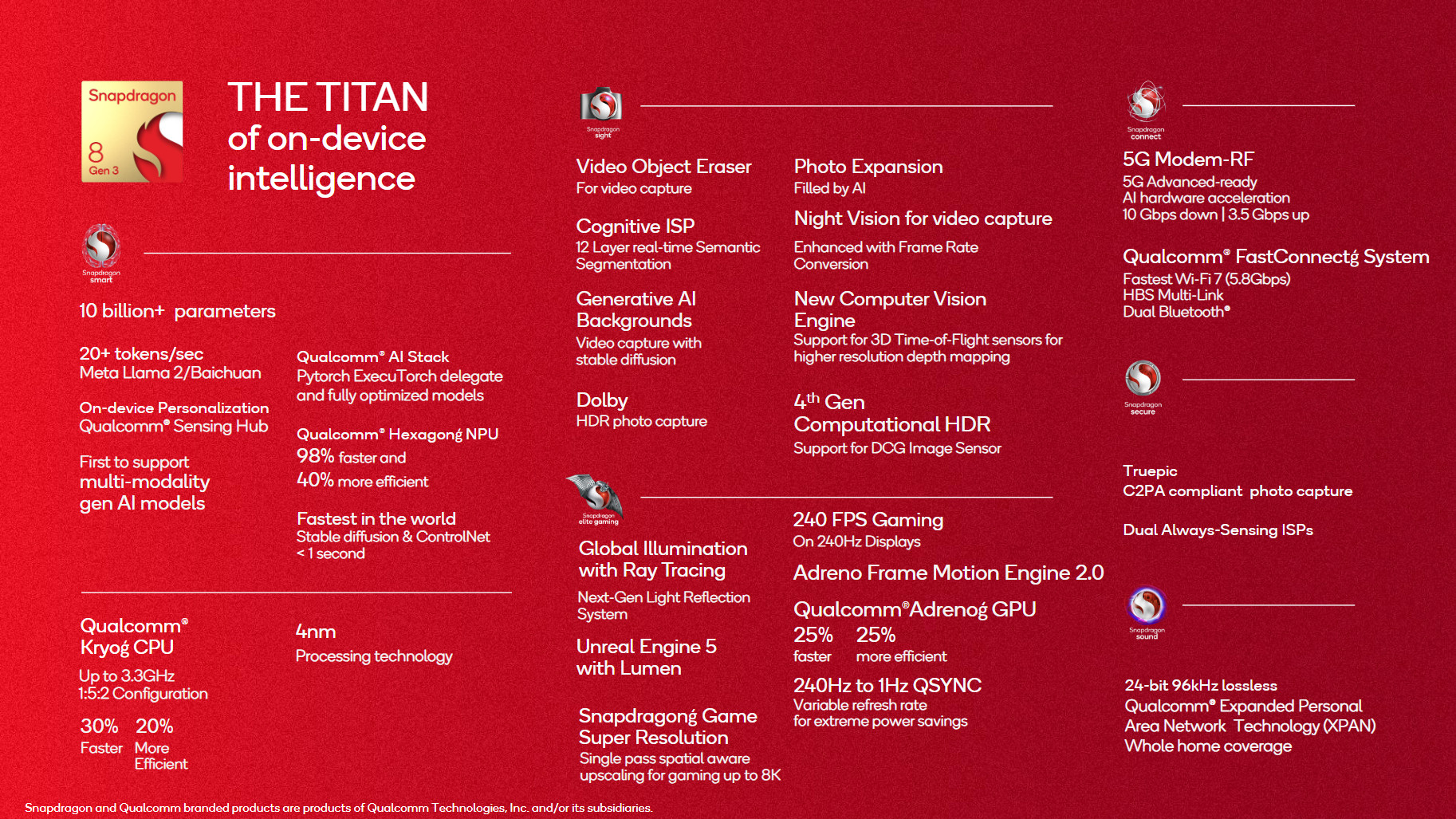
Robert Triggs / Android Authority
Chipmaker Qualcomm has announced the latest SoC in its high-end Snapdragon 8 family, the Snapdragon 8 Gen 3. The chip will power most of the flagship Android phones released through the end of 2023 and throughout most of 2024. A wide range of brands have committed to adopting this chip, and some, like Xiaomi, have already announced devices powered by it. But what upgrades does the new Snapdragon 8 Gen 3 bring to the table, and how does it compare to Qualcomm’s former best, the Snapdragon 8 Gen 2? Let’s break it down.
Snapdragon 8 Gen 3 vs Snapdragon 8 Gen 2: Specs
With its latest Snapdragon 8 Gen 3 chip, Qualcomm is promising a big performance and efficiency improvement. Here’s a spec table that showcases what the company has changed between the two chip generations.
| Snapdragon 8 Gen 3 | Snapdragon 8 Gen 2 | |
|---|---|---|
|
CPU Config |
Snapdragon 8 Gen 3
1x 3.3GHz (Cortex-X4) |
Snapdragon 8 Gen 2
1x 3.19GHz (Cortex-X3) |
|
GPU |
Snapdragon 8 Gen 3
Adreno |
Snapdragon 8 Gen 2
Adreno 740 |
|
DSP |
Snapdragon 8 Gen 3
Hexagon |
Snapdragon 8 Gen 2
Hexagon |
|
RAM support |
Snapdragon 8 Gen 3
LPDDR5X |
Snapdragon 8 Gen 2
LPDDR5X |
|
Camera support |
Snapdragon 8 Gen 3
• 200MP single shot |
Snapdragon 8 Gen 2
• 200MP single shot |
|
Video capture |
Snapdragon 8 Gen 3
8K @ 30fps (HDR) |
Snapdragon 8 Gen 2
8K @ 30fps (HDR) |
|
Charging |
Snapdragon 8 Gen 3
Quick Charge 5 |
Snapdragon 8 Gen 2
Quick Charge 5 |
|
4G/5G Modem |
Snapdragon 8 Gen 3
X75 LTE/5G (integrated) |
Snapdragon 8 Gen 2
X70 LTE/5G (integrated) |
|
Other networking |
Snapdragon 8 Gen 3
Bluetooth 5.4 |
Snapdragon 8 Gen 2
Bluetooth 5.3 |
|
Process |
Snapdragon 8 Gen 3
TSMC 4nm (N4P) |
Snapdragon 8 Gen 2
TSMC 4nm (N4?) |
Qualcomm has made some interesting changes to its formula compared to last year, with the Snapdragon 8 Gen 3 adding an extra medium core and dropping a little core. Even though the total core count remains the same at eight, we’re getting a different 1+5+2 core layout that places more emphasis on the middle tier. The cores themselves are different too. The Snapdragon 8 Gen 3 includes Arm’s latest Cortex-X4 big core, Cortex-A720 medium cores, and Cortex-A520 cores.
Qualcomm has also clocked each core higher than last year, with the Snapdragon 8 Gen 3’s big core topping 3.3GHz and three of the medium cores achieving 3.2GHz. For comparison, last year’s Snapdragon 8 Gen 2’s big core came close at 3.2GHz. However, all four medium cores were capped at 2.8GHz.
Qualcomm’s latest SoC gets big clock speed bumps across all cores.
While we can’t directly compare clock speeds between cores from different generations, it’s still a good sign for performance as we’ll discuss in the section on real-world benchmarks below. And despite the clock speed increase, Qualcomm says it hasn’t compromised on power draw. The new CPU is 20% more efficient than its predecessor.
It’s worth noting that Qualcomm’s inclusion of the latest Arm cores means that the Snapdragon 8 Gen 3 is a 64-bit-only chipset. Put simply, some older Android apps that haven’t been updated in nearly a decade will no longer run on the newer SoC. If that matters to you, the last-gen Snapdragon 8 Gen 2 will go down as the last flagship chipset to support 32-bit apps.
As is typically the case, the Snapdragon 8 Gen 3 packs a new Adreno GPU. Qualcomm pegs it at 25% faster vs the Snapdragon 8 Gen 2’s Adreno 740 and promises an equal 25% improvement in efficiency. Ray tracing gets a monstrous 50% performance uplift this generation, but we haven’t seen many compelling applications of the technology on mobile yet.
The new Adreno GPU also has a few other tricks up its sleeve, namely 8K display-out and 240Hz support. Even so, Qualcomm believes that this GPU generation represents an evolutionary upgrade rather than an outright overhaul.
Snapdragon 8 Gen 3 vs Snapdragon 8 Gen 2: Benchmarks

Hadlee Simons / Android Authority
With the theory out of the way, how does the Snapdragon 8 Gen 3 fare in actual tests? We’re now in a position to answer that question, thanks to Qualcomm’s reference device that showcases the chip at its best. We’ve compiled our testing in a dedicated Snapdragon 8 Gen 3 benchmark article, but here’s a quick look at how it compares to its predecessor.
In GeekBench 6, Qualcomm’s latest chip puts up an impressive showing and lives up to the company’s claimed performance figures. The Snapdragon 8 Gen 3 offers a 40% uplift in multi-core and 18% improvement in single-core vs last year’s Snapdragon 8 Gen 2 in 2023 phones.
The gap is slightly smaller when compared to Qualcomm’s device from last year, which is expected as retail devices don’t always match the reference. Still, it’s an impressive result, with the Snapdragon 8 Gen 3 achieving 31% higher peak performance year-over-year. The new Cortex-X4 and Cortex-A720 cores seem to live up to their promise.
The Snapdragon 8 Gen 3 delivers big CPU and GPU performance improvements.
The winning streak continues on the GPU side. Our 3DMark Wild Life scores give the Snapdragon 8 Gen 3 a 40% lead over last year’s chip, which is above and beyond the claimed 25%. Qualcomm has reportedly alleviated some Vulkan-specific bottlenecks, which should help explain the increased performance in select titles. Likewise, ray tracing can become a target for developers now that the Snapdragon 8 Gen 3 offers 50% better performance.
However, it’s not all good news. The Snapdragon 8 Gen 3 starts out strong but nosedives to half of its peak performance within a few runs of the 3DMark Wildlife Stress Test. Smartphones equipped with last year’s Snapdragon 8 Gen 2 didn’t fall off quite as hard. The latter SoC’s performance simply declined gradually over time. We’ll be sure to test this behavior in gaming and other demanding tasks once we have the first Snapdragon 8 Gen 3 phones in our hands.
Snapdragon 8 Gen 3 vs Snapdragon 8 Gen 2: AI and other features

Supplied by Qualcomm
Last year, the Snapdragon 8 Gen 2 introduced some long-awaited features like support for the AV1 video codec, LPDDR5X RAM, UFS 4.0, and Wi-Fi 7. All of these carry over to the Snapdragon 8 Gen 3 too, along with some more improvements. AI has also taken center stage in the tech world and Qualcomm is embracing that trend wholesale with its new flagship SoC. Here’s a quick rundown of the new features coming to the Snapdragon 8 Gen 3:
- According to Qualcomm, the Snapdragon 8 Gen 3’s Hexagon NPU offers nearly double the performance vs the Snapdragon 8 Gen 2. It’s also 40% more efficient and has been designed with generative AI in mind.
- The Snapdragon 8 Gen 3 can run large language models (LLMs) on-device. The company showcased a chatbot demo powered by Meta’s Llama 2 language model, which is an open-source competitor to ChatGPT.
- Beyond text, the Snapdragon 8 Gen 3 also supports multi-modal models that can locally handle text, image, and even speech. For example, the chip can create an AI-generated image using Stable Diffusion within a minute. It can also erase objects in videos, a step beyond Google’s Magic Eraser which only works for still photos.
- Qualcomm’s AI focus extends to the chip’s image processing pipeline too, with the chip’s Night Vision Video capable of shooting usable footage in very dark settings.
- Likewise, a new Photo Expansion feature uses generative AI to extend any image beyond its original boundaries. This is a feature we’ve seen already from the likes of Photoshop Generative Fill, but it’s new on mobile.
- The Snapdragon 8 Gen 3 introduces support for Dolby HDR photo capture with 10-bit color depth.
While these features sound very promising, it’s worth noting that their implementation is entirely up to device makers. Based on past releases, we know that only a small subset of Snapdragon 8 series’ features end up in actual consumer devices every year. If you’re considering an upgrade, we’d recommend checking out a review or two beforehand.
Snapdragon 8 Gen 3 vs Snapdragon 8 Gen 2: Phones and bottom line

Ryan Haines / Android Authority
The Snapdragon 8 Gen 2 powers many of the best Android smartphones released in 2023. We’ve almost universally praised it on account of its superb performance and efficiency. The Snapdragon 8 Gen 3 looks like a worthy successor in just about every area. Having said that, we have some lingering questions about sustained performance, given our early test results. After all, this is an area where Android SoCs have struggled in the past.
Qualcomm released the Snapdragon 8 Gen 3 on October 24, 2023. It didn’t take long for the first phone sporting the chipset to hit the market in the form of the Xiaomi 14 series, albeit only in China for now. The SoC is expected to power many high-end smartphones throughout 2024, including big names like Samsung’s Galaxy S24 family.
The last-gen Snapdragon 8 Gen 2 is plenty capable of powering smartphones for years to come.
Simultaneously, however, we don’t expect the Snapdragon 8 Gen 2 to disappear just yet. Qualcomm’s previous-gen SoCs have often made a comeback later in their life cycles in upper mid-range and sub-flagship smartphones. The same should hold true for this last-gen chip too. And considering the amount of performance on offer, it’s undoubtedly a great choice even if it’s no longer the best.
So with that in mind, which SoC should you prioritize for your next smartphone? Given the huge performance uplift, we’d say the Snapdragon 8 Gen 3 does eke out a win vs the Snapdragon 8 Gen 2. However, that equation may change slightly if you can find deep discounts on a smartphone toting the older SoC.
FAQs
Yes, both the 8 Gen 2 and 8 Gen 3 support hardware-based ray tracing. However, the 8 Gen 3 offers a 50% performance boost, according to Qualcomm.
Yes. Both offer plenty of performance and cutting-edge features like ray-tracing, AI capabilities, and Wi-Fi 7. Being newer, the Snapdragon 8 Gen 3 is the most future-proof of the two.
Neither chip suffers from widespread overheating issues. That said, some smartphone designs are better at dissipating heat than others, meaning some handsets perform at higher levels for longer.



